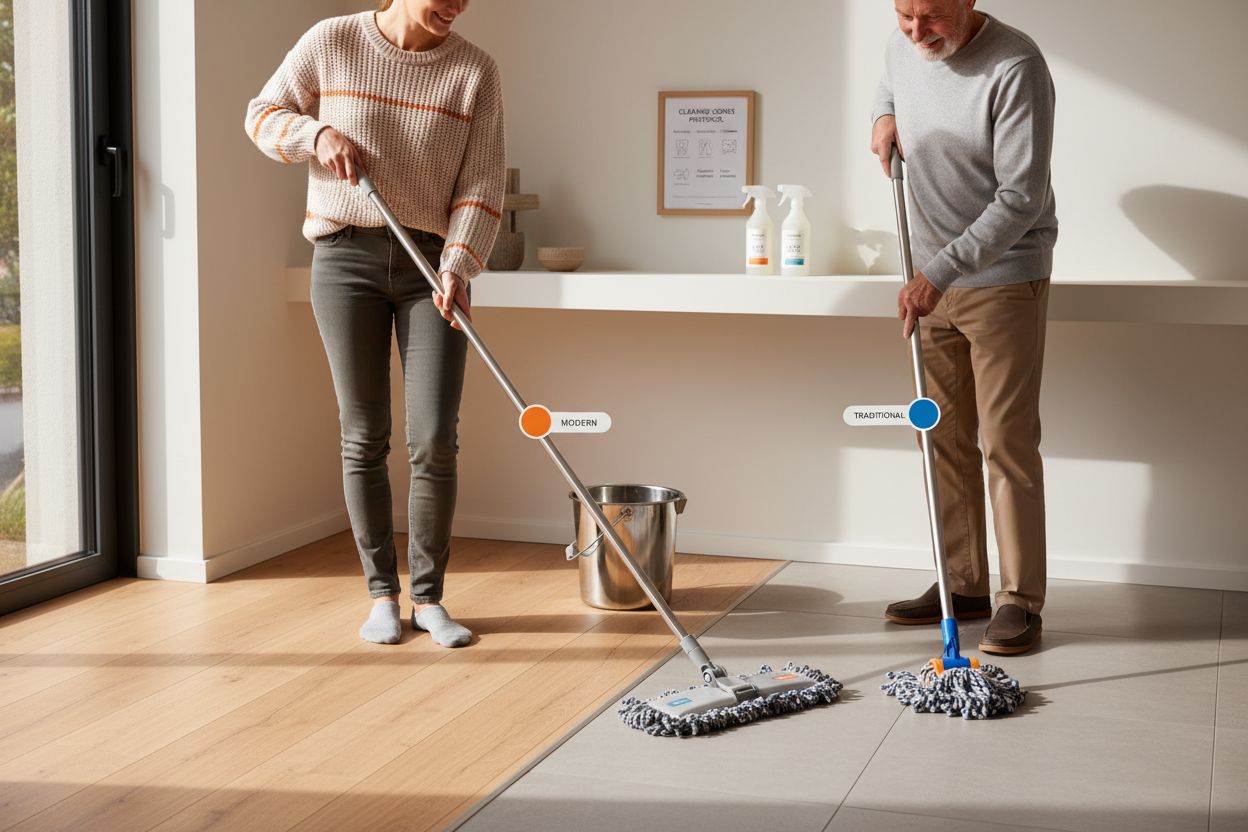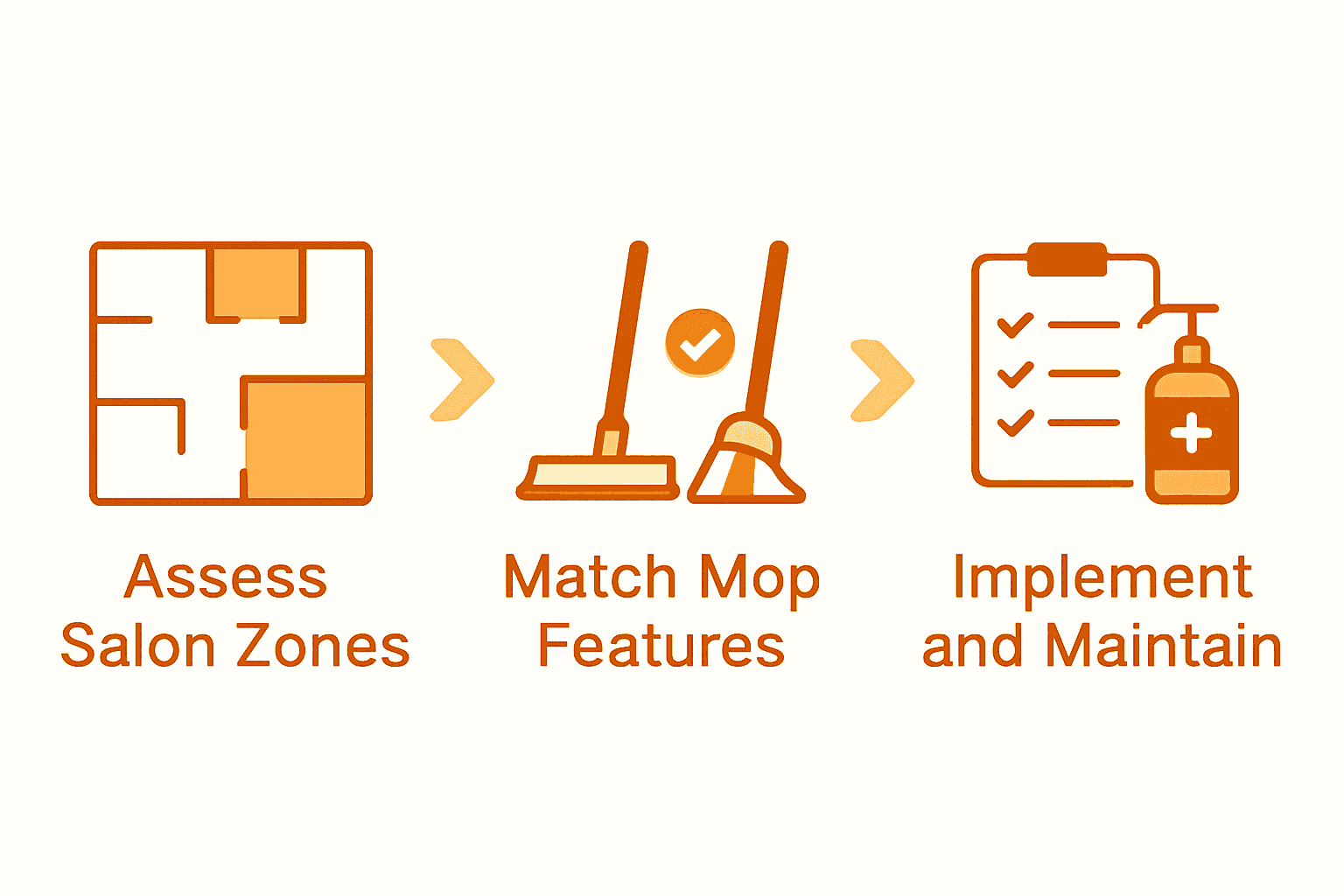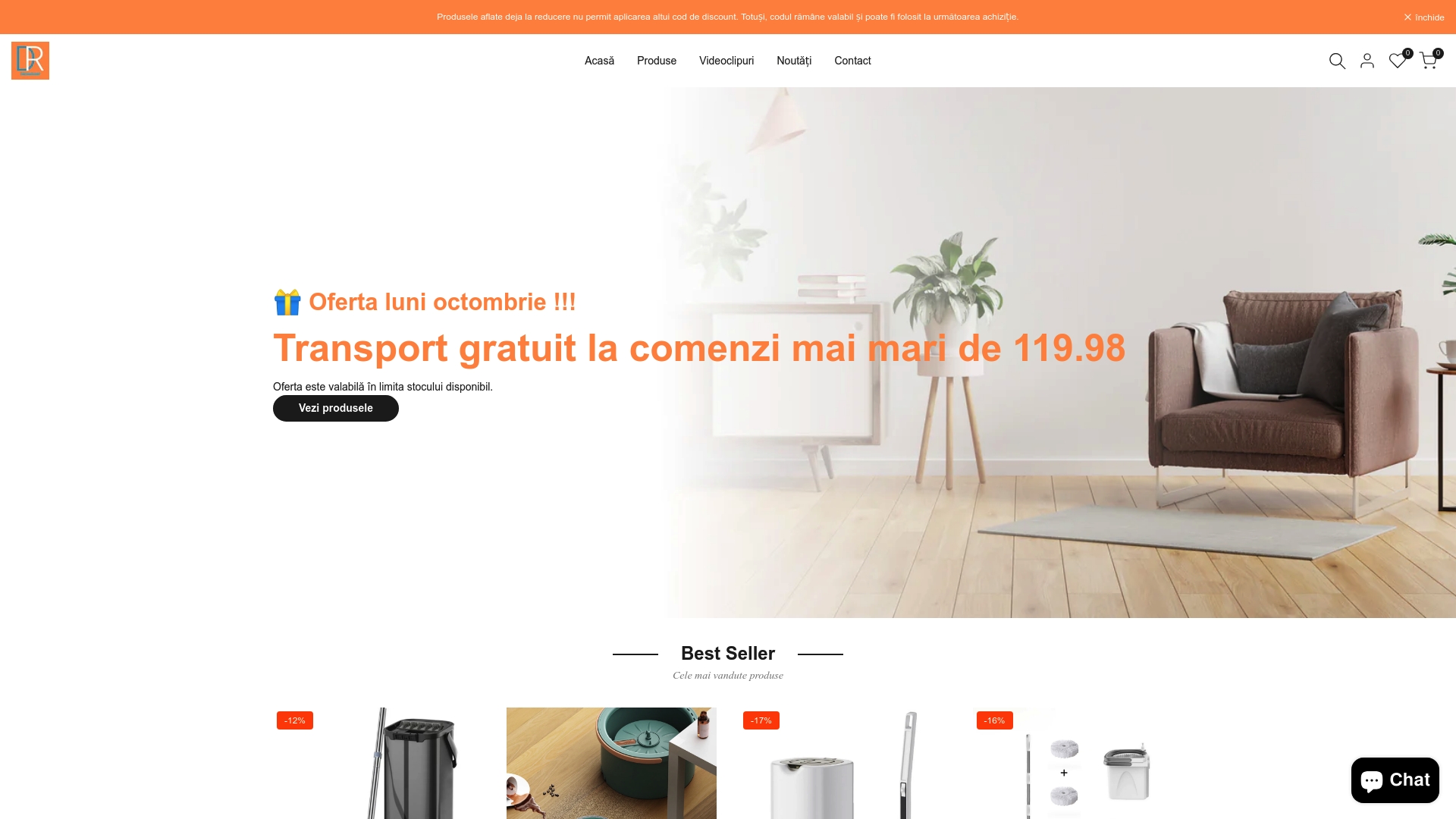Did you know that salons can harbor up to 340 types of bacteria on common surfaces? Cleanliness isn’t just about looking professional, it directly impacts your clients’ safety and your salon’s reputation. Making smart choices about cleaning routines and equipment can help prevent the spread of germs and set your business apart from the competition. With the right strategies, your salon can stay spotless, inviting, and trusted every day.
Quick Summary
| Key Point | Explanation |
|---|---|
| 1. Assess unique cleaning requirements | Conduct a thorough evaluation of your salon’s space to create a tailored hygiene blueprint, addressing specific cleaning needs. |
| 2. Choose appropriate mop technologies | Explore modern mop options like microfibre and touch-free systems that minimize cross contamination and improve cleaning efficiency. |
| 3. Match mop features to salon zones | Select mop features based on specific areas within the salon to enhance hygiene and maintain efficient cleaning protocols. |
| 4. Test mops in real-world conditions | Perform practical evaluations to understand each mop’s performance in various salon situations, focusing on efficiency and usability. |
| 5. Establish rigorous maintenance protocols | Implement comprehensive hygiene standards that include cleaning, sanitization, and proper storage for your mop systems to ensure ongoing effectiveness. |
Table of Contents
- Step 1: Assess Salon Cleaning Requirements
- Step 2: Evaluate Mop Types and Technologies
- Step 3: Match Mop Features to Salon Needs
- Step 4: Test Shortlisted Mops in Real Conditions
- Step 5: Verify Hygiene and Maintenance Standards
Step 1: Assess Salon Cleaning Requirements
In this critical first step, you will systematically evaluate your salon’s unique cleaning needs and create a strategic hygiene blueprint that ensures client safety and professional standards. Your goal is to develop a comprehensive cleaning approach tailored specifically to your salon’s environment.
Start by conducting a thorough walkthrough of your entire salon space. According to the European Cleaning Journal, reducing cross contamination requires meticulous attention to every surface and potential transmission point. This means examining floors, workstations, treatment areas, waiting rooms, restrooms and storage spaces with a critical eye.
Key areas you want to assess include:
- Floor surface materials (tile, wood, linoleum)
- Traffic patterns and high touch zones
- Equipment and furniture cleaning requirements
- Potential moisture or spill risks
- Client contact surfaces
Pay special attention to infection prevention strategies. Modern salon hygiene isn’t just about appearances—it’s about creating a safe environment that protects both clients and staff. This means understanding which cleaning methods work best for different surfaces and identifying potential cross contamination risks.
Pro Tip: Always document your initial assessment. A written inventory of cleaning requirements helps create consistent protocols and makes future training easier.
Your next step will involve selecting appropriate cleaning tools and products that match the specific needs you’ve identified during this assessment. By taking a methodical approach now, you’re setting the foundation for a consistently clean and professional salon environment.
Step 2: Evaluate Mop Types and Technologies
Now that you have assessed your salon’s cleaning requirements, it is time to dive deep into selecting the most appropriate mop technology that will transform your hygiene protocols. Your mission is to understand the modern landscape of mopping solutions and identify the perfect match for your salon’s specific needs.
According to the European Cleaning Journal, the cleaning world has dramatically evolved from traditional cotton mops to sophisticated microfibre technologies. Research indicates that modern mops offer superior dirt and microbe removal capabilities compared to their predecessors.
Start by examining different mop categories:
Here’s a comparison of popular salon mop types and their key features:
| Mop Type | Hygiene Level | Ergonomics | Best For |
|---|---|---|---|
| Microfibre Flat Mop | High Reduces microbes |
Lightweight Easy to handle |
All floor types High-traffic zones |
| Cotton Kentucky Mop | Moderate Prone to cross contamination |
Heavier Manual wringing |
Basic cleaning Large open areas |
| Touch-Free System | Very High Minimizes contact |
Excellent Reduces strain |
Sensitive zones Frequent cleaning |
| Color Coded System | High Reduces cross use |
Varies Based on mop type |
Zone-specific cleaning Preventing mix-ups |
- Flat microfibre mops
- Traditional cotton Kentucky mops
- Advanced touch free handling systems
- Color coded cleaning systems
From recent industry research, manual mops still hold significant advantages in accessibility and cost effectiveness. Look for features like ergonomic designs and antimicrobial materials such as silver ion yarn that can enhance your cleaning effectiveness.
Pro Tip: Consider your salon floor type when selecting a mop. Different surfaces require different microfibre densities and material compositions.
Your priority should be finding a mop system that minimizes cross contamination while providing maximum cleaning efficiency. Pay attention to technologies that offer separate water compartments and allow for touch free wringing to maintain optimal hygiene standards.

In the next step, you will learn how to match these mop technologies with your specific salon cleaning protocols to create a comprehensive and effective cleaning strategy.
Step 3: Match Mop Features to Salon Needs
With your initial cleaning assessment and mop technology research complete, you are now ready to strategically match specific mop features to your salon’s unique cleaning requirements. Your objective is to transform theoretical knowledge into a practical cleaning solution that maximizes efficiency and hygiene.
According to the European Cleaning Journal, modern mop features go far beyond basic cleaning capabilities. Professional salons need equipment that delivers ergonomic design, lightweight performance, and advanced functionality.
Key features to evaluate include:
- Microfibre material composition
- Handle ergonomics and weight
- Quick release mechanisms
- Color coding potential
- Overall system sustainability
- Expected equipment lifespan
From professional cleaning equipment research, microfibre systems stand out for salons because they offer superior hygiene performance. Look for mops with specialized microfibre technologies that can effectively capture microscopic debris and reduce cross contamination risks.
Pro Tip: Invest in mop systems with modular components. This allows you to replace specific parts rather than entire systems and reduces long term costs.
Consider your salon’s specific zones when matching mop features. Reception areas might need different cleaning approaches compared to treatment rooms or restrooms. A color coded system can help staff maintain strict hygiene protocols across different salon spaces.

In the next step, you will learn how to implement your selected mop technology into a comprehensive cleaning workflow that ensures maximum salon cleanliness and client safety.
Step 4: Test Shortlisted Mops in Real Conditions
With your carefully researched mop technologies in hand, you are now ready to conduct real world performance evaluations that will separate good cleaning tools from exceptional salon solutions. Your goal is to simulate actual salon conditions and thoroughly assess each mop’s practical capabilities.
According to European Cleaning Journal, manual mops offer unique advantages in accessibility and adaptability. This means you will want to test each shortlisted mop in multiple salon scenarios to understand its true performance potential.
Create a systematic testing protocol that covers multiple performance dimensions:
- Cleaning efficiency across different floor surfaces
- Ease of maneuverability in tight spaces
- Speed of dirt and moisture removal
- Operator comfort and physical strain
- Cross contamination prevention capabilities
From industry research, key features like quick release mechanisms and ergonomic designs can significantly impact your testing outcomes. Pay close attention to how each mop handles real world salon challenges such as hair product spills, makeup residue, and high traffic areas.
Pro Tip: Involve multiple staff members in your testing to get diverse perspectives on mop performance and ergonomic comfort.
Document your findings meticulously.
Note specific strengths and limitations of each mop system. Look beyond surface level cleaning and evaluate long term durability and maintenance requirements.
In the next step, you will analyze your testing results and make a final selection that transforms your salon’s cleaning approach.
Step 5: Verify Hygiene and Maintenance Standards
After thoroughly testing your shortlisted mops, you have arrived at a critical phase where you will establish rigorous hygiene and maintenance protocols that ensure your salon cleaning tools remain effective and safe. Your mission is to transform your selected mop system into a reliable infection prevention instrument.
According to the European Cleaning Journal, maintaining optimal hygiene requires more than just selecting the right equipment. You need a comprehensive strategy that addresses storage, cleaning, sanitization, and prompt usage of your mop systems.
Key maintenance standards to implement include:
- Immediate cleaning after use
- Proper drying techniques
- Regular sanitization of handles and equipment
- Systematic replacement of microfibre components
- Chemical management for effective disinfection
Research from Diversey Europe demonstrates that launderable flat mops with biocidal products can dramatically reduce bacterial cross contamination compared to traditional cleaning methods.
Pro Tip: Develop a color coded system for different salon zones to prevent cross contamination and streamline your cleaning protocols.
Establish a regular maintenance schedule that includes detailed cleaning logs, periodic equipment assessment, and staff training on proper mop handling. Remember that consistent maintenance is just as important as the initial mop selection.
In the final step, you will learn how to implement your comprehensive salon cleaning strategy and create a sustainable hygiene framework.
Upgrade Your Salon’s Hygiene, Comfort, and Client Confidence
Are you struggling to find the perfect mop that eliminates cross contamination, fits ergonomic needs, and delivers superior cleaning for every inch of your salon? This Mop Selection Guide highlights the core challenge: balancing advanced hygiene protocols with real, practical cleaning solutions. If your current mop system falls short in preventing germ spread, is hard to maintain, or lacks the durability your busy salon demands, it is time for a change. At DreamRamp.ro, you will discover innovative mopping systems with advanced microfibre technology, color-coded options, and sets that guarantee clean and dirty water are kept separate—proven solutions built around the problems that matter most to professionals like you.

Make your next mop investment the last one you second guess. Visit DreamRamp.ro now to see cleaning tools designed for demanding environments. Choose solutions that make cleaning effortless, keep staff safer and reassure every client that your space meets the highest hygiene standards. Explore our full range and start transforming your salon’s cleaning routine today.
Frequently Asked Questions
What factors should I consider when assessing my salon’s cleaning requirements?
To assess your salon’s cleaning requirements, examine surfaces like floors and workstations, evaluate traffic patterns, and identify high-touch areas. Conduct a thorough walkthrough of your space to document specific cleaning needs.
How do I choose the right type of mop for my salon?
Select a mop by evaluating its hygiene level, ergonomics, and suitability for different floor surfaces. For example, consider a microfibre flat mop for high-traffic zones and a touch-free system for sensitive areas, ensuring it matches your salon’s specific cleaning requirements.
What features should I look for when matching mop technologies to my salon needs?
Key features to look for include microfibre material composition, ergonomic handles, quick-release mechanisms, and sustainability options. Prioritize mops that can efficiently capture dust and debris while enabling you to maintain hygiene standards effortlessly.
How can I effectively test shortlisted mops in my salon?
Conduct performance evaluations under real salon conditions by assessing how each mop performs on different surfaces and in various scenarios. Document your findings on cleaning efficiency and user comfort to make an informed final decision on the best mop for your needs.
What maintenance standards should I implement for my cleaning mops?
Establish maintenance standards such as cleaning mops immediately after use, proper drying techniques, and regular sanitization of equipment. Create a maintenance log to track procedures, enabling you to keep your mop systems functioning effectively and hygienically.
How can I prevent cross-contamination while cleaning my salon?
Implement a color-coded cleaning system to designate specific mops for different salon areas, preventing cross-usage. Ensure that all staff are trained on these protocols to maintain optimal hygiene standards throughout your salon.









